View in other NatureServe Network Field Guides
NatureServe
Montana
Utah
Wyoming
Idaho
Wisconsin
British Columbia
South Carolina
Yukon
California
New York
Packard's Grasshopper - Melanoplus packardii
General Description
The following taken from Brooks (1958), Vickery and Kevan (1985), Pfadt (2002), Capinera et.al. (2004), Capinera and Sechrist (1982), Brust et al. (2008, 2010), and Scott (2010). A medium to large size grasshopper with the body color ranging from dark grayish brown, reddish-brown, to yellowish-brown. A dark stripe occurs across the top of the head extending across the pronotum to the posterior margin. The wings (tegmina) are long, extending to the abdomen tip or 6 mm beyond. The wings are often speckled with small spots. The outer face of the femur is yellowish with a dark stripe along the upper edge. The hind tibia is blue or red (mostly blue in Montana).
Phenology
Overwinters in the egg stage. Eggs hatch from May to early June. Nymphs occur from June through August. Adults are active from mid-July through September. (Vickery and Kevan 1985, Pfadt 2002, Capinera et al. 2004, Capinera and Sechrist 1982, Brus, et al. 2008 and 2010, and Scott 2010).
Diagnostic Characteristics
The following comes from Brooks (1958), Vickery and Kevan (1985), Pfadt (2002), Capinera et al. (2004), Capinera and Sechrist (1982), Brust et al. (2008 and 2010), and Scott (2010). Adult body length to end of forewings for males is 22 to 33 mm, and females 26 to 37 mm. Visual diagnostic characteristics are the length of the dorsal stripe on the pronotum and the color of the hind tibia. However, only by examining the aedeagus can identification be certain between the other species in the “
M. packardii group.”
M. packardii is often confused with
Striped Sand Grasshopper (
M. foedus) and
M. fluviatillis which is now a recognized separate species. These 3 species are in what is termed as the “
Melanoplus packardii group.” Their status as species have been questioned many times regarding their status as subspecies or a full species. Essentially, these 3 species are truly “look-a-likes” in that the male genitalia are nearly identical.
M. packardii tends to be slightly smaller and darker in color than
Striped Sand Grasshopper (
M. foedus) (Brust et al. 2008 and 2010), Capinera and Sechrist 1982). Refer to the Pictorial Key to the “
Melanoplus packardii Group" above for identification assistance.
Species Range
Montana Range
Range Descriptions
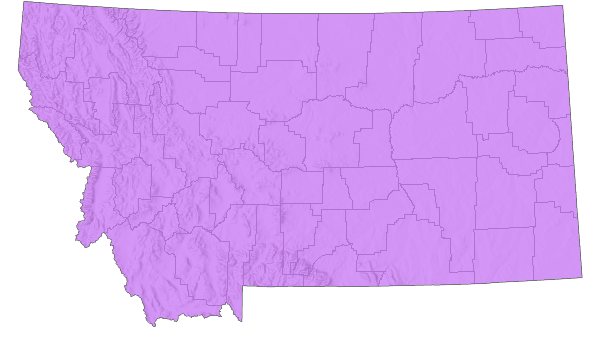
 Native
Native
Range Comments
The following comes from Vickery and Kevan (1985), Pfadt (2002), (Capinera et al. (2004), Capinera and Sechrist (1982), and Brust et al. (2008 and 2010), and Scott (2010). This species is widely distributed in western North America throughout the Great Plains west of the Mississippi River to the Pacific states, south to Texas, New Mexico, Arizona, and north to Manitoba, Saskatchewan, Alberta, and British Columbia. In Montana, it has been recorded in 51 counties, but likely occurs throughout the state.
Observations in Montana Natural Heritage Program Database
Number of Observations: 35
(Click on the following maps and charts to see full sized version)
Map Help and Descriptions
Relative Density
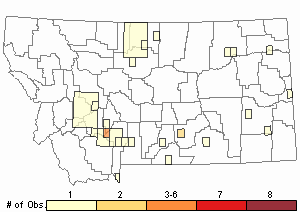
Recency
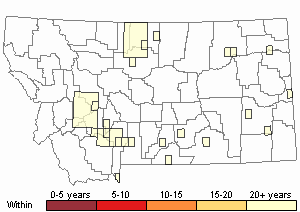

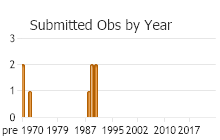
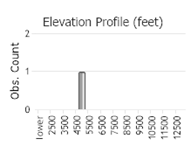 (Observations spanning multiple months or years are excluded from time charts)
(Observations spanning multiple months or years are excluded from time charts)
Habitat
Over its large geographical range, it does not generally occupy the same habitats as
Striped Sand Grasshopper (
M. foedus). The Packard's Grasshopper is a prairie species, inhabiting short-grass, tall-grass, mixed-grass habitats, especially where light, sandy, gravelly or drift soils occur. It also inhabits agricultural crop areas, making it a significant pest species. It occurs in mountain meadows up to 9000 feet (Vickery and Kevan 1985, Pfadt 2002, Capinera et al. 2004, Capinera and Sechrist 1982, and Schell et al. 2005).
Food Habits
The Packard's Grasshopper is a polyphagous species, feeding on both grasses and forbs, with a preference for legumes. Some studies recorded this species feeding on seven grasses and 26 forbs in short grass and mixed grass prairies. Some of its favored host species include
alfalfa (
Medicago sativa),
western ragweed (
Ambrosia psilostachya),
lead plant (
Amorpha canescens),
white sagebrush (
Artemisia ludoviciana),
Artemisia species, sunflower and scurf-pea (
Psoralidium sp.). It is also known to feed on winter wheat, barley, and fall rye (Pfadt 2002, Capinera et al. 2004, Capinera and Sechrist 1982, and Vickery and Kevan 1985).
Reproductive Characteristics
c. After hatching, the nymphs pass through 5 instars before reaching the adult stage. Females prefer bare ground for oviposition. The egg pod contains 17 to 29 eggs arranged in 2 or 3 columns. Some field observations indicate that males begin courting about 20 days after adult emergence, and female oviposition about 36 days after adult emergence. The average longevity of a Packard's Grasshopper has been estimated to be 50 days (Pfadt 2002, and Capinera and Sechrist 1982).
Management
The following is taken from Pfadt (2002), Capinera et al. (2004), Capinera and Sechrist (1982), and Schell et al. (2005). The Packard's Grasshopper has adapted well to human modified habitats, such as cropland edges, roadsides, fencerows, and abandoned farmlands. It is prone to population outbreaks in certain areas and can comprise 50 percent of local grasshopper species’ diversity. On rangelands it is not considered a major pest problem, but in croplands, it can cause serious damage to cereal grains and legumes.
Stewardship Responsibility
References
- Literature Cited AboveLegend:
 View Online Publication
View Online Publication Brooks, A.R. 1958. Acridoidea of Southern Alberta, Saskatchewan, and Manitoba (Orthoptera). The Canadian Entomologist (Supplement 9) 90:5-92.
Brooks, A.R. 1958. Acridoidea of Southern Alberta, Saskatchewan, and Manitoba (Orthoptera). The Canadian Entomologist (Supplement 9) 90:5-92. Brust, M.L, W.W. Hoback, and R.J. Wright. 2008. The Grasshoppers of Nebraska. Lincoln, NB: University of Nebraska Extension Service, APHIS.
Brust, M.L, W.W. Hoback, and R.J. Wright. 2008. The Grasshoppers of Nebraska. Lincoln, NB: University of Nebraska Extension Service, APHIS. Brust, M.L., E.J. Landroth, W.W. Hoback, R.J. Wright, K. Hanford and J.E. Foster. 2010. Morphological and genetic analyses in the Melanoplus parckardii group. Journal of Orthoptera Research 19:281–288. doi: 10.1665/034.019.0215.
Brust, M.L., E.J. Landroth, W.W. Hoback, R.J. Wright, K. Hanford and J.E. Foster. 2010. Morphological and genetic analyses in the Melanoplus parckardii group. Journal of Orthoptera Research 19:281–288. doi: 10.1665/034.019.0215. Brust, M.L., W.W. Hoback, and R.J. Wright. 2008. A Synopsis of Nebraska Grasshopper Distributions. Journal of the Kansas Entomological Society 81(3):208-255.
Brust, M.L., W.W. Hoback, and R.J. Wright. 2008. A Synopsis of Nebraska Grasshopper Distributions. Journal of the Kansas Entomological Society 81(3):208-255. Capinera, J.L. and T.S. Sechrist. 1982. Grasshoppers of Colorado: Identification, Biology, and Management. Fort Collins, CO: Colorado State University Experiment Station, Bulletin 584S. 161 p.
Capinera, J.L. and T.S. Sechrist. 1982. Grasshoppers of Colorado: Identification, Biology, and Management. Fort Collins, CO: Colorado State University Experiment Station, Bulletin 584S. 161 p. Capinera, J.L., R.D. Scott, and T.J. Walker. 2004. Field Guide to Grasshoppers, Katydids, and Crickets of the United States. Ithaca, NY. Cornell University Press.
Capinera, J.L., R.D. Scott, and T.J. Walker. 2004. Field Guide to Grasshoppers, Katydids, and Crickets of the United States. Ithaca, NY. Cornell University Press. Pfadt, R.E. 2002. Field Guide to Common Western Grasshoppers, 3rd edition. Laramie, WY: Wyoming Agricultural Experiment Station, Bulletin 912, modified by S. Schell and S. Schell for electronic publication. Accessed 19 February 2020. http://www.uwyo.edu/entomology/grasshoppers/field-guide/index.html#fieldguidetoc
Pfadt, R.E. 2002. Field Guide to Common Western Grasshoppers, 3rd edition. Laramie, WY: Wyoming Agricultural Experiment Station, Bulletin 912, modified by S. Schell and S. Schell for electronic publication. Accessed 19 February 2020. http://www.uwyo.edu/entomology/grasshoppers/field-guide/index.html#fieldguidetoc Schell, S.P., A.V. Latchininsky, and B.A. Shambaugh. 2005. Common Wyoming Pest Grasshoppers. 2nd Edition B-1161.Laramie, WY: University of Wyoming Cooperative Extension Service and Department of Renewable Resources. 76 p.
Schell, S.P., A.V. Latchininsky, and B.A. Shambaugh. 2005. Common Wyoming Pest Grasshoppers. 2nd Edition B-1161.Laramie, WY: University of Wyoming Cooperative Extension Service and Department of Renewable Resources. 76 p. Scott, R.D. 2010. Montana Grasshoppers, Katydids, and Crickets A Pictorial Field Guide to the Orthoptera. MagpieMTGraphics, Billings, MT.
Scott, R.D. 2010. Montana Grasshoppers, Katydids, and Crickets A Pictorial Field Guide to the Orthoptera. MagpieMTGraphics, Billings, MT. Vickery, V. R. and D. K. M. Kevan. 1985. The grasshopper, crickets, and related insects of Canada and adjacent regions. Biosystematics Research Institute, Ottawa, Ontario. Publication Number 1777. 918 pp.
Vickery, V. R. and D. K. M. Kevan. 1985. The grasshopper, crickets, and related insects of Canada and adjacent regions. Biosystematics Research Institute, Ottawa, Ontario. Publication Number 1777. 918 pp.
- Additional ReferencesLegend:
 View Online Publication
View Online Publication
Do you know of a citation we're missing? Anderson, N.L. 1951. Field studies on the biology of range grasshoppers of southeastern Montana. M.Sc. Thesis. Bozeman, Montana: Montana State University. 96 p.
Anderson, N.L. 1951. Field studies on the biology of range grasshoppers of southeastern Montana. M.Sc. Thesis. Bozeman, Montana: Montana State University. 96 p. Anderson, N.L. 1962. Grasshopper-vegetation relationships on Montana grasslands. Ph.D Dissertation. Bozeman, Montana: Montana State University. 73 p.
Anderson, N.L. 1962. Grasshopper-vegetation relationships on Montana grasslands. Ph.D Dissertation. Bozeman, Montana: Montana State University. 73 p. De Smet-Moens, H. 1982. The insect fauna of Canada Thistle Cirsium arvense (L.) Scop in southern Montana. M.Sc. Thesis. Bozeman, MT: Montana State University. 51 p.
De Smet-Moens, H. 1982. The insect fauna of Canada Thistle Cirsium arvense (L.) Scop in southern Montana. M.Sc. Thesis. Bozeman, MT: Montana State University. 51 p. Gillespie, R.L.1992. Dynamics of grasshoppers (Orthoptera: Acrididae) at a rangeland-crop interference. Ph.D. Bozeman, MT: Montana State University. 111 p.
Gillespie, R.L.1992. Dynamics of grasshoppers (Orthoptera: Acrididae) at a rangeland-crop interference. Ph.D. Bozeman, MT: Montana State University. 111 p. Hebard, M. 1928. The Orthoptera of Montana. Proceedings of the Academy of Natural Sciences of Philadelphia, Vol. 80:211-306.
Hebard, M. 1928. The Orthoptera of Montana. Proceedings of the Academy of Natural Sciences of Philadelphia, Vol. 80:211-306. Hebard, M. 1932. Notes on Montana Orthoptera. Proceedings of the Academy of Natural Sciences of Philadelphia. V. 84. pp 251-257.
Hebard, M. 1932. Notes on Montana Orthoptera. Proceedings of the Academy of Natural Sciences of Philadelphia. V. 84. pp 251-257. Henry, J.E. 1969. Protozoan and viral pathogens of grasshoppers. Ph.D. Dissertation. Bozeman, MT: Montana State University. 153 p.
Henry, J.E. 1969. Protozoan and viral pathogens of grasshoppers. Ph.D. Dissertation. Bozeman, MT: Montana State University. 153 p. Larson, D.P. 1996. Evaluation of sweep sampling as a method for determining grasshopper community composition on rangeland. M.Sc. Thesis. Bozeman, MT: Montana State University. 92 p.
Larson, D.P. 1996. Evaluation of sweep sampling as a method for determining grasshopper community composition on rangeland. M.Sc. Thesis. Bozeman, MT: Montana State University. 92 p. Mussgnug, G.L. 1972. The structure and performance of an adult population of Aulocara elliotti (Thomas) (Orthoptera, Acrididae) near Billings, Montana. M.Sc. Thesis. Bozeman, MT: Montana State University. 97 p.
Mussgnug, G.L. 1972. The structure and performance of an adult population of Aulocara elliotti (Thomas) (Orthoptera, Acrididae) near Billings, Montana. M.Sc. Thesis. Bozeman, MT: Montana State University. 97 p. Sater, S. 2022. The insects of Sevenmile Creek, a pictorial guide to their diversity and ecology. Undergraduate Thesis. Helena, MT: Carroll College. 242 p.
Sater, S. 2022. The insects of Sevenmile Creek, a pictorial guide to their diversity and ecology. Undergraduate Thesis. Helena, MT: Carroll College. 242 p. Skinner, K.F. 1995. Plant and grasshopper community composition: indicators & interactions across three spatial scales. M.Sc. Thesis. Bozeman, MT: Montana State University. 144 p.
Skinner, K.F. 1995. Plant and grasshopper community composition: indicators & interactions across three spatial scales. M.Sc. Thesis. Bozeman, MT: Montana State University. 144 p. Wachter, D.H. 1995. The ecology of selected grasshopper species along an elevational gradient. M.Sc. Thesis. Bozeman, Montana: Montana State University. 59 p.
Wachter, D.H. 1995. The ecology of selected grasshopper species along an elevational gradient. M.Sc. Thesis. Bozeman, Montana: Montana State University. 59 p.
- Web Search Engines for Articles on "Packard's Grasshopper"
- Additional Sources of Information Related to "Insects"





